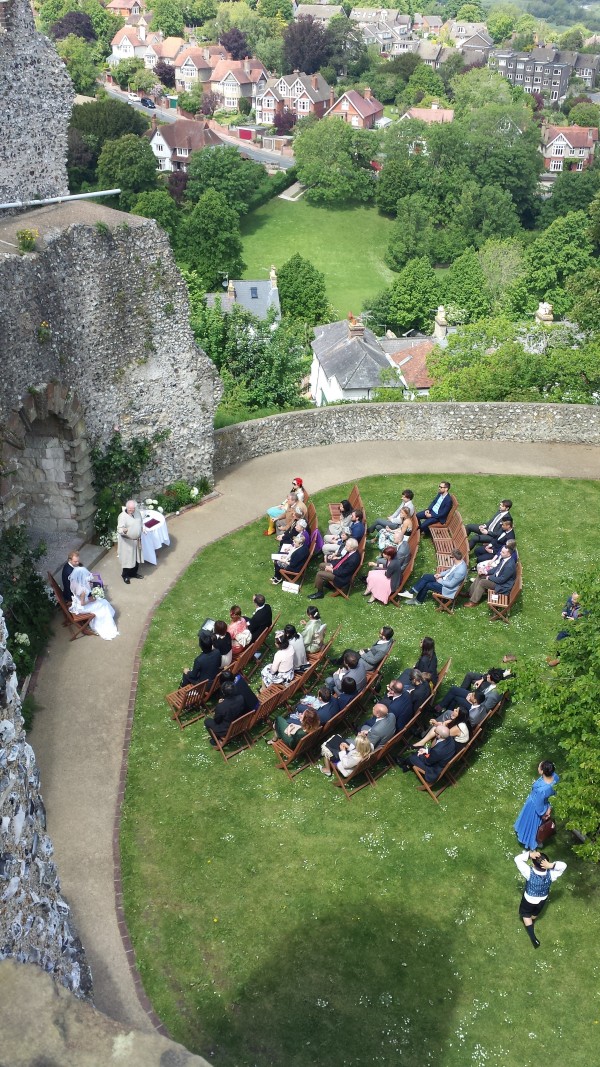
by Michael | Aug 11, 2015 | Blog
Where to have your wedding? The location is obviously one of the first things that couples want to arrange. For one thing, the more popular venues may be booked up a year or more in advance. Secondly, the atmosphere of the wedding can largely be dictated by the sort of venue chosen, so it’s not a decision to be taken lightly.
First considerations
Obvious things to consider are your budget. How much money do you want to devote to this? If you choose a less usual date or time of day, you may be able to secure the venue at a better price. Obviously, you will need estimates, possibly from several venues, before you commit.
The size of the venue is clearly important – you don’t want the wedding party engulfed in a huge area, but you certainly don’t want to be squashed together for the ceremony or reception. A preliminary visit, together with the events planner, is essential. Be prepared to ask lots of questions and be absolutely clear what the price actually includes.
Would you be intimidated by a castle setting, say, or do you want to push the boat out and go up the Shard or hire a Stately Home? Would something more homely suit?
And go with your gut. Is this a place where you feel you can be really happy?
Logistics
The next question is: are you going to want to have your reception at the same location as your ceremony? If not, you’ll need to think about the logistics. Will the party drive from the wedding venue to the reception? What about non-drivers? How long should you allow for this? Will your reception be spoilt, if it takes longer than you think to reach the venue? Is parking going to be an issue?
Unconventional Ceremonies
Naturally, the type of wedding you want will also dictate where you have it. If you are planning a handfasting wedding, then you’re probably going to have it in a field or at an Iron Age fort, for example. You’ll need to get permission from the landowner and you’ll have to decide what sort of reception you hold, if any – and where.
If you want a secular wedding, then the registrars have to be involved for the legal bit. If you want them to come out to a location of your choosing, it will have to have solid walls, for example (ie a marquee won’t do). So do your homework here.
If you don’t want a full religious service (eg church, synagogue, etc) but you want more than the routine register office ceremony, you can have the best of all worlds with a civil celebrant-led ceremony. Then you can have the service that you want in the location of your choice.
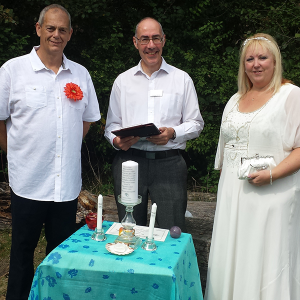
Civil Celebrant limitations
I am often asked what limits my availability, as regards location. Well, I can’t conduct a service in a C of E church, but that’s about it. Any other location – from hotels and restaurants to the Stonehenge inner circle, to a mountain top, a canalside, a back garden or underwater ( think creative!) – all these are technically available for wedding ceremonies.
Personal availablity
I live in Harrow, so I tend to work mostly in London, Herts. and Bucks., but I have conducted other ceremonies in Salisbury, Andover, Worthing , Epsom and the like. I guess that I haven’t been further afield because travel expenses inflate the fee. However, I was invited to conduct a wedding blessing in Ibiza last year – unfortunately, to my great regret, I had a clash of dates.
If you’re not planning to have your celebration in the South of England, don’t let it deter you from asking me for a quote. I’d love to help make your big day really special, wherever you choose. I can be surprisingly flexible!
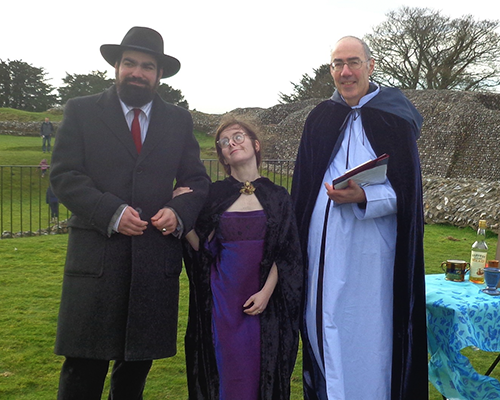
by Michael | May 26, 2015 | Blog
Judging by the questions I get asked, a lot of people really don’t know what a handfasting is. I therefore hope it will be helpful if I say a few words about it. It forms a central part in pagan ceremonies, but is often chosen as a colourful “extra” in a traditional wedding.
It may be something you would like to consider.
History
Handfastings originated in Celtic times, but began as a marriage rite in the Middle Ages. When peasants married, they might have been unable to afford a clergyman’s fee to hear their vows or a ring to signify their love. The ritual of handfasting became a popular alternative.
A cord was wrapped round the wrists of the couple and left on them until their union was consummated. It would usually be kept afterwards as a tangible reminder and proof of their commitment and love.
This ceremony has, of course, given us the expression “tying the knot”.
Present-day Ceremony
Nowadays, the cord symbolises the pair’s mutual love. The way a handfasting can be slipped in to a traditional-type wedding is as follows, although this is only a suggestion, and it will be different for a full pagan ceremony.
- Walking down the aisle to be given away by the father
- Officiant welcome
- Address about the meaning of love (possibly from a religious slant, if that’s wanted)
- Optionally, the couple’s ‘story’
- Here, or after the Handfasting, or at both times, a song or a reading/poem
- Handfasting
- Possibly, a Unity Candle, Sand Ceremony or Chalice ritual
- Exchange of Rings/Vows
- Jumping the Broom (not actually pagan, but deriving from wedding ceremonies conducted by slaves in the American South), now used to symbolise sweeping in the new as the new home is created
- Concluding words
Thoughts
As a celebrant, my favourite handfasting was part-pagan, part-Jewish containing rituals from both sides. Of course, I explained the symbolism for those unfamiliar with the other’s practices, so everyone could understand, and this worked really well to create a warm atmosphere. For example, the bride walked round the groom seven times while the groom recited his wife’s virtues (Jewish tradition), before we did the pagan handfasting.
It was a totally unique occasion – absolutely perfect for the couple and – clearly – for the guests too.
It’s something your civil celebrant will be able to advise you about.
If you want to add extra sparkle and personality to your big day, you could do a lot worse than try a handfasting.
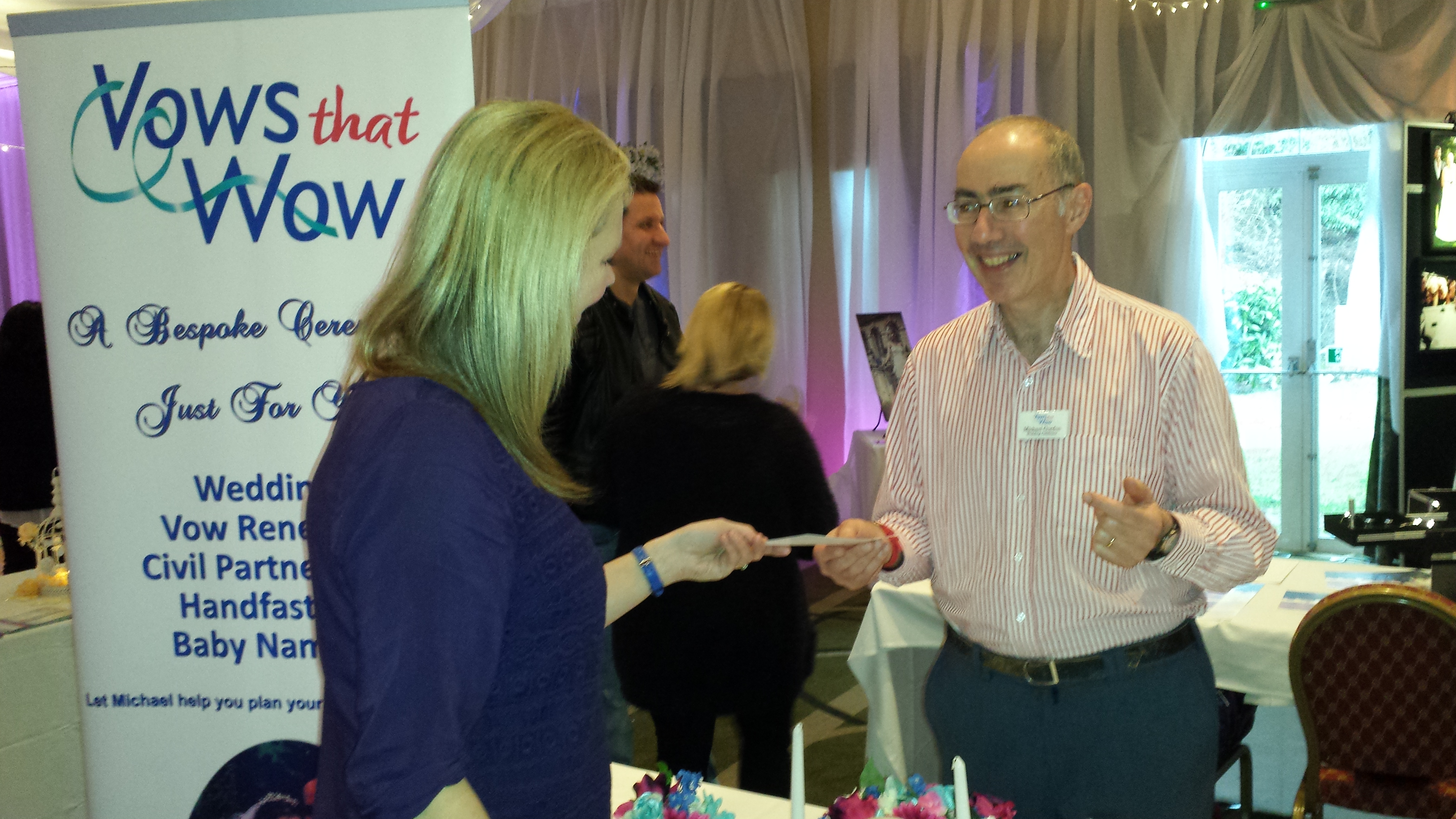
by Michael | May 12, 2015 | Blog
Being on the other side of the fence at wedding fairs, I tend to note all sort of reactions from visitors. Of course, some are attending their very first show and are unsure what to expect; others may be attending for very specific purposes (it could be to see the venue or find a photographer, for example). I suppose some might be there for the freebies!
However, there is potentially a lot to take in and it can be a bit overpowering. I therefore offer a few tips that may help you get the most out of the experience.
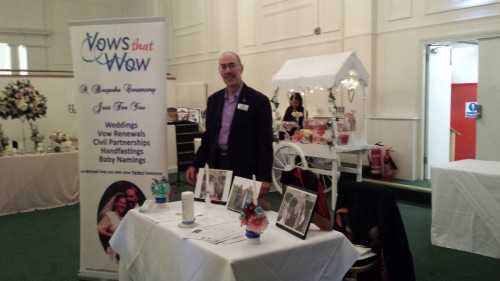
Hints
- Arrive early. It tends to be less crowded then – and you are more likely to get freebies!
- Unless you’re focussed on finding just one particular supplier, such as a cake-maker, try and be methodical and cover all the aisles. You never know what you might otherwise miss.
- Don’t worry that stallholders will try and engage you. They won’t be offended if you’re not interested in their services; be curious, though. If you’re looking for ideas, they may have something to offer that you hadn’t expected. For example, quite a few people don’t know what a civil celebrant like myself offers, and are glad they stopped to chat.
- Make the experience as pleasant as possible. Do exchange smiles with others, even if you walk away with nothing from the stallholders. You may spend longer at the fair than you’re expecting; you may be on your feet a long time. You may also end up with quite a bit to carry (there are usually goody bags, in addition to flyers you may pick up along the way), so try not to encumber yourselves before you even arrive. Maybe avoid surplus clothing, depending on the weather outside. And do at least wear comfortable shoes. Bring some bottled water, so you don’t dehydrate.
- Be prepared to ask questions and to listen. This is an information-gathering exercise, so don’t feel inhibited. By all means, be prepared to make notes as you go through. You can also gain a useful snapshot of the enthusiasm and professionalism of your would-be supplier. You’re going to want to know you’ll feel a rapport with me, if I am to be creating your wedding ceremony and conducting it on the day!
- Collect cards and flyers from vendors. When you leave the show, you will probably feel overwhelmed and tired, and may not remember who told you what. This way you’ll be able to follow up with any supplier you want to. Incidentally, if you have a business card yourself (or prepare your own label), you can leave it with a supplier whom you want to contact you, and save time.
- There may be a fashion show. That can give you some good ideas, but if you’re already sorted with your dress, this might be a quiet and more relaxed time to visit the stalls instead.
- There will be things on sale you might not be expecting and opportunities to sign up with suppliers at special prices, so it may be as well to bring your wallet with you. And if you have a camera, you can take a snap to remind you at a later date what attracted you.
Meet the Celebrant!
My next wedding fair is on Sunday, 17th May at the prestigious Compleat Angler, Marlow. My book “Your Wedding Guide” will be available to purchase at my stand, and I’d be delighted to meet you and answer any questions you may have about conventional ceremonies or handfastings, say. (If you tell me you’ve come along as a result of this article, I’ll offer you 10% off any ceremony you may book with me!)
by Michael | Sep 16, 2014 | Blog
We like – and need – rites of passage. These include baptism, confirmation,weddings, 21st birthdays, and (less popular!) death. They may also include Vow Renewals.
Vow renewals can seem irrelevant to you, unless you’re approaching a significant date or know of someone else who is. So what is the point of them?
Why consider a Vow Renewal?
- You’ve got through a whole year of marriage. You’ve learned how to share, compromise and live together. Well done! Why not mark this achievement in some way?
- You’ve managed five, ten, fifteen or twenty (you get the picture!) years together. Now that’s a real achievement! You could certainly recognise that in company with your friends and relatives.
- Maybe your marriage has been rocky, but you’ve come out on the other side, and you want to re-commit publicly.
- Maybe you married abroad, and would like to share the occasion with your friends over here.
- Perhaps you have acquired a whole new set of friends and even relatives since marrying.
- Maybe the vows you took have become irrelevant and need reformulating and restating.
- You might even simply be looking for an excuse for a celebration!
These are just some reasons to consider having a public ceremony, or Vow Renewal.
Advantages
You can have your ceremony wherever you choose (of course, you may need to get permission, etc.).
You can invite whoever you want and as many people as your budget allows.
You can include whatever you wish in the ceremony – readings, ritual, music, readers, etc. Your civil celebrant can advise and guide you. (Note that you will have the final say)
The tone of the ceremony (light-hearted, formal, etc.) is up to you.
You can include whatever elements matter to you – eg ring blessing, rewritten vows, handfasting, for example.
It needn’t be an expensive ceremony: at a basic level, you will need to pay for the venue (if you’re booking one), the civil celebrant, refreshments (if you’re having any), a new set of clothes, possibly, and not much else.
Examples
I have officiated at venues as different as a Mayfair hotel and a Canal Centre. The Shard has been suggested as a venue, as has Waterloo Bridge and even at sea on the Queen Elizabeth. For a handfasting vow renewal, the inner circle at Stonehenge is an option. And so it goes on …
If you can think of anybody who might appreciate a ceremony of this kind, I’d love to chat to them about it.
Michael Gordon can help prepare and conduct a tailor-made civil ceremony in or around London, or, indeed, in Europe.
by Michael | Jun 18, 2014 | Blog
The Summer Solstice is almost upon us (depending when you read this!). It’s a fantastic time for handfastings. “For what?” I hear some of you say.
Allow me to elaborate.
If you don’t know, I shall assume that you are not a Druid or pagan, and if you are, please understand that I am writing this for the uninitiated. There are, however, different kinds of handfastings, so there’s no single answer to the question.
Example of a handfasting
Remember when Kate and Prince William got married? Although it was a religious C of E ceremony, there was an element of handfasting in there when the couple took each other’s hands, and they were covered by a ribbon.
It was a lovely simple ritual.
Now if you take that one step further and bind the two hands together, you have a handfasting.
Incidentally, this gives rise to the expression “tying the knot” and also “bonds of holy matrimony”.
Origins
This ceremony probably originated in Celtic times; however, it flourished in Europe until the mid 1700s. Up till then, few unions were sanctified in a religious building like a church. Rather, they were celebrated by a simple handfasting ceremony in which the two partners joined hands over the village anvil, in the fields or in the groves of trees. Today, we build upon this tradition.
The basics
The couple link and cross hands (normally right hand to right, and left to left) to form an infinity circle, symbolising the entirety of the universe as represented in their relationship. Then, with a cord or ribbon (or ribbons), the wrists are tied and knotted, in a lovers’ knot, to the accompaniment of a suitable text, to symbolise the joining together of the two people in lives and spirits.
The cords are then removed, normally by the couple – occasionally, with difficulty! – with the knots still in place. They will take the cord away with them and, ideally, it will remind them of their vows, should they hit a rocky patch.
Where does this happen?
Again, it depends, but many people prefer a quiet, open-air historic site that may be considered to be spiritual and preferably pagan – such as standing stones.
What about Stonehenge?
A civil celebrant, such as myself, can conduct a handfasting wedding or vow renewal in the Inner Circle at Stonehenge (normally around dawn or dusk), but this needs to be booked months in advance (and the Druids will have priority at the solstice). However, places like Avebury, Old Sarum or the Rollright Stones might do very well.
it’s a little late for this Summer, but do have a chat (020 8866 4326) and see if we can sort something very special out for you!
Michael Gordon can help prepare and conduct a tailor-made civil ceremony (including a handfasting) in or around London or, indeed, in Europe.





